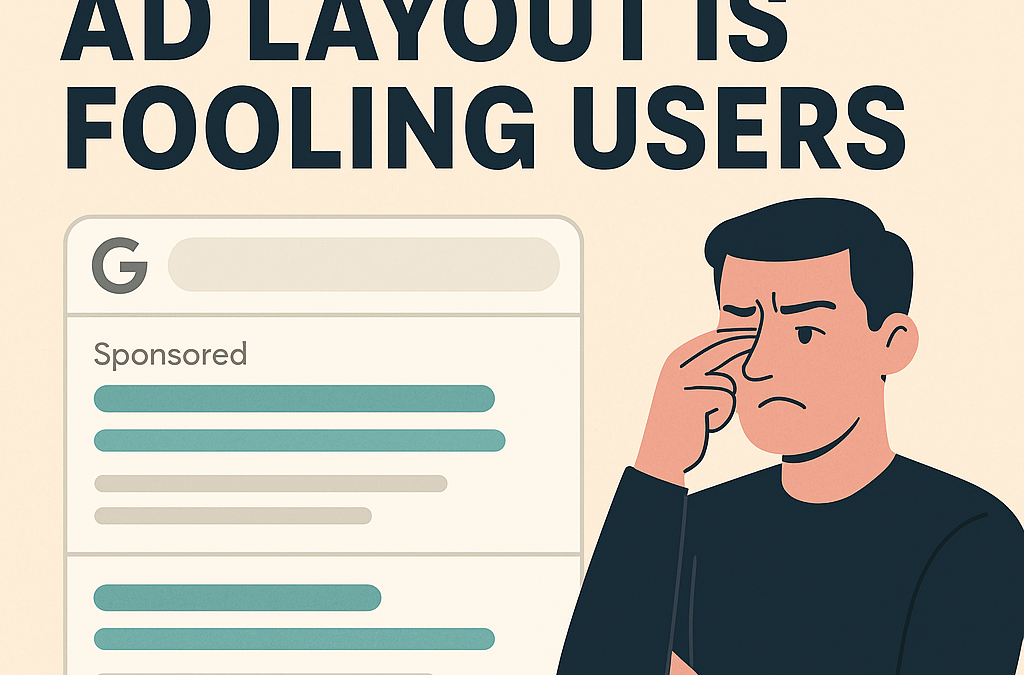Google’s New Ad Layout Is Fooling Users — What It Means for Your Business
If you’ve noticed strange behavior in your Google Ads performance lately, you’re not imagining things. Google’s latest change to its ad layout is creating a confusing user experience—one that even savvy marketers are falling for.
63% of marketers said they’ve unintentionally clicked on a Google ad under the new layout.
— Search Engine Roundtable (Barry Schwartz)
At Content Engagement Lab, we’ve been monitoring this closely. In a recent video, our founder Chris Bernard broke it down in real time. The takeaway? This isn’t just a design refresh—it’s a shift in how users engage with sponsored content, and it could affect your conversion rates and ad spend efficiency.
What Changed in Google’s Ad Layout?
Google recently introduced a new visual format for its paid search results. Instead of labeling each individual ad clearly as “Sponsored,” Google now groups multiple ads under a single, subtle “Sponsored” banner at the top of the search results.
On both desktop and mobile, this grouped layout now looks more like organic results than ever before. The design difference is so slight that many users don’t realize they’re clicking on an ad until after the fact.

Why This Matters: Unintentional Clicks and Your Budget
Let’s be clear: Google’s new grouped ad layout increases the chances of accidental clicks, particularly on mobile. While more clicks might look good on a report, they don’t necessarily mean higher-quality leads or better ROI.
If users are clicking because they think your ad is an organic result, you could end up with:
- Increased cost per click (CPC) without a boost in qualified leads
- Higher click-through rates (CTR) that don’t translate into actual sales
- Lower conversion rates as users bounce quickly from your landing page
For businesses managing a focused PPC budget—especially in competitive industries like healthcare—these misaligned clicks can lead to real inefficiencies.
What You Should Do Now
Here are three key steps we recommend:
1. Audit Your Google Ads Performance
Analyze recent data and compare the last 30 days to the previous month. Key metrics to review:
- Bounce rate
- Conversion rate
- Time on page
- CTR vs. actual conversions or sales
2. Refine Your Ad Copy and Landing Pages
Clear and specific ad copy can help filter the right traffic. Ensure alignment between the keyword, ad message, and landing page. This helps prevent clicks from unqualified users who misunderstood your offer.
3. Review Your Ads on Google
Manually search your top keywords and review how your ads are rendering. Are they blending in too much with organic results? If so, that could be driving unintentional clicks.
Final Thoughts from Chris Bernard
“Go take a look at your AdWords traffic, see what happens. My expectation? You’ll see a drop in actual conversions if the wrong audience is clicking. But if your ad is done properly—you might just benefit. Either way, be aware and adjust.”
– Chris Bernard, Founder, Content Engagement Lab
Stay Ahead of the Curve with Content Engagement Lab
At Content Engagement Lab, we don’t just manage campaigns—we optimize every step of your customer journey. From precise targeting to conversion-focused messaging, we track and adjust your campaigns in real-time, especially when platforms like Google make disruptive changes like this one.
Want to know how this update is affecting your ad performance? Let’s schedule a quick audit and give you clear, actionable insight.
Contact us today to learn more.


Recent Comments